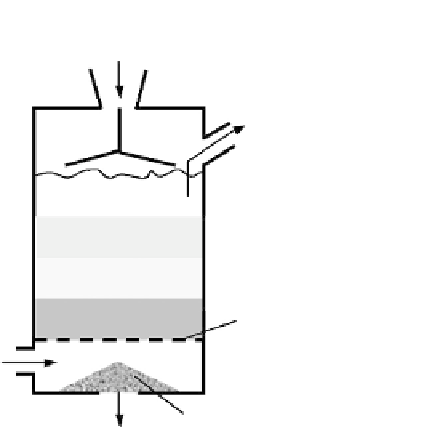Biomedical Engineering Reference
In-Depth Information
Biomass
Gas
Drying
Pyrolysis
Gasification
Grate
Oxidation
Steam plus air
Ash
FIGURE 8.3
Schematic of an updraft gasifier.
Oils (SASOL) for production of gasoline from coal. The following is a brief
description of
two important
large-scale commercial updraft gasifier
technologies.
8.2.1.1 Dry-Ash Gasifier
Lurgi, a process development company, developed a pressurized dry-ash
updraft gasifier. It is called dry ash because the ash produced is not molten.
One that produces molten ash is called a slagging gasifier.
Though the peak temperature (in the combustion zone) is 1200
C, the
maximum gasification temperature is 700
900
C. The reactor pressure is in
the neighborhood of 3 MPa, and the residence time of coal in the gasifier is
between 30 and 60 min (Ebasco Services Inc., 1981). The gasification
medium is a mixture of steam and oxygen, steam and air, or steam and
oxygen-enriched air. It uses a relatively high steam/fuel carbon ratio (
1.5).
The coal is first screened to between 3 and 40 mm (Probstein and Hicks,
2006, p. 162) and then fed into a lock hopper. The gasifying agent moves
upward in the gasifier while the solids descend. The reactor is a double-
walled pressure vessel. Between the two walls lies water that quickly boils
into steam under pressure, utilizing the heat loss from the reactor. As the
coal travels down the reactor, it undergoes drying, devolatilization, gasifica-
tion, and combustion. Typical residence time in the gasifier is about an hour
(Probstein and Hicks, 2006, p. 162). In a dry-ash gasifier, the temperature is
lower than the melting point of ash, so the solid residue dries and is removed
from the reactor by a rotating grate.
B




Search WWH ::

Custom Search